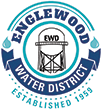Reclaimed Water Frequently Asked Questions
What is reclaimed water?
EWD’s reclaimed water is highly treated wastewater produced through an advanced secondary wastewater treatment process. This process eliminates any harmful by-products while retaining some beneficial elements, such as nitrogen, for irrigating landscape.
What are the benefits of using reclaimed water?
Reclaimed water creates an alternate water source for irrigation by reducing demand on potable water sources utilized for drinking water. Reduces the cost of landscape irrigation when it replaces potable water. Reduces fertilizer costs due to some nitrogen and phosphorus in reclaimed water. Beautifies our community by enhancing the appearance of landscaping.
How is Reclaimed Water Processed?
The wastewater treatment and disinfection process requires four steps:
- Step 1 eliminates solid materials
- Step 2 uses microorganisms to break down smaller solids.
- Step 3 eliminates undesirable compounds and fine suspended particles.
- Step 4 uses chlorine to eliminate micro-organisms.
What is the quality of reclaimed water?
Englewood Water District produces reclaimed water that meets Federal primary drinking water standards, and all the State requirements for utilization of reclaimed water for irrigation of public access areas (parks, playgrounds, school sites, golf courses, etc.), and irrigation of residential lawns and landscapes.
Inorganic contaminants EWD Water Reclamation Facility Chloride (mg/l) 294 Nitrate (mg/l) (as Nitrogen) 6.98 pH (standard unit) 7.1 Phosphorus (mg/l) 1.63 Chloride– naturally occurring salt content present in all water types.
-
Nitrate (as Nitrogen) – a nutrient that stimulates plant growth and is associated with lush, dark green leaves
-
Milligrams per Liter (mg/L) – one part by weight of analyte to 1 million parts by weight of the water sample.
-
pH – the measure of acidity or alkalinity with 7 as the neutral amount.
-
Phosphorus – promotes healthy root development and aids in plant establishment.
Is reclaimed water safe?
Yes. To ensure safety, the highest standards established by the Florida Department of Environmental Protection are followed. System controls utilized by EWD are among the most stringent in the nation. Many Florida municipalities safely operate reclaimed water systems.
There is no documentation of any public health problems associated with reuse of properly treated and disinfected reclaimed water. As a precaution, it is recommended that immunecompromised persons irrigate only when they will not be outside.
The level of treatment received by reclaimed water makes it acceptable for the following uses:
Irrigating lawns and most landscaping;
Washing of cars, boats, or heavy equipment. (It is recommended that after the use of reclaimed water, vehicles are rinsed with potable water and towel-dried to prevent spotting.)
Washing of roofs and buildings.
Use in fountains and decorative pools (they must be clearly marked as containing reclaimed water).
State restrictions do not allow reclaimed water to be used for:
Bathing, cooking or toilet flushing in residential dwellings.
Any interconnection with another water source.
Recreational use involving body contact (i.e., swimming pools or outdoor showers).
Irrigation of vegetables or other edible crops which are not peeled, cooked, or thermally processed before being consumed.
Run-off into or filling of swimming pools.
What types of plants thrive on reclaimed water?
In general, any plant native to this area will grow well when irrigated with reclaimed water.
| Common Name | Botanical Name | Preferred Conditions |
|---|---|---|
| Banana | Musa acuminate | Full sun; Moist soil |
| Blue Porterweed | Stachytarpheta spp | Partial shade; Moist-dry soil |
| Bougainvillea | Bougainvillea spectabilis | Full sun; Moist, well drained soil |
| Croton | Codiaeum variegatum | Full sun to Partial Shade; Moist soil |
| Dahon Holly | Ilex cassine | Open, sunny areas; Moist soil |
| Day Lilies | Hemerocallis spp | Full sun to Partial shade; Moist soil |
| Hibiscus | Hibiscus roa-sinensis | Full sun; Moist, well-drained soil |
| King Sago | Cycas revolute | Full sun to Partial shade; Dry to Moist soil |
| Lantana | Lantana camera | Full Sun; Dry to Moist soil |
| Liriope | Liriope muscari | Partial shade; Moist, well-drained soil |
| Live Oak | Quercus virginiana | Full sun; Dry to Wet soil |
| Queen Sago | Cycas circinalis | Full sun to Partial shade; Moist, well-drained soil |
| Society Garlic | Tulbaghia violacea | Partial to full sun; Well-drained soil |
| Southern Magnolia | Magnolia grandiflora | Full sun to Partial shade; Moist to Wet soil |
What do I need to know about connecting to reclaimed water, where available?
The program is voluntary and you can utilize your existing in-ground irrigation system.
If you have a well, you must disconnect it from the irrigation system in order to take advantage of the program.
Irrigation systems connected to a drinking water line must be disconnected.
No cross connection can exist prior to the tie-in to the reclaimed water system.
A cross connection inspection conducted by an EWD, Reclaimed Water Inspector, is required at the time the actual tie-in to the reclaimed service is made.
How do I apply for reclaimed water service?
Call 941-474-3217 or e-mail info@englewoodwater.com to receive information on availability.
What is the reclaimed water rate?
“Please see our Customer Rules and Regulations for the current rate information.”
All Reclaimed Water Accounts are billed monthly.
Are there restrictions on reclaimed water use?
From time to time, it may be necessary to implement tighter restrictions depending on the rainfall amounts at the Water Reclamation Facility. Please check this web site periodically for updated information on possible restrictions. In Florida, responsible stewardship of our water resources is especially important. How we use, conserve, and manage our water supply will greatly affect our quality of life now, and even more so in the future. It takes the wastewater from 4 homes to supply 1 home with reclaimed water. Reclaimed water is a limited resource and should be used efficiently.
